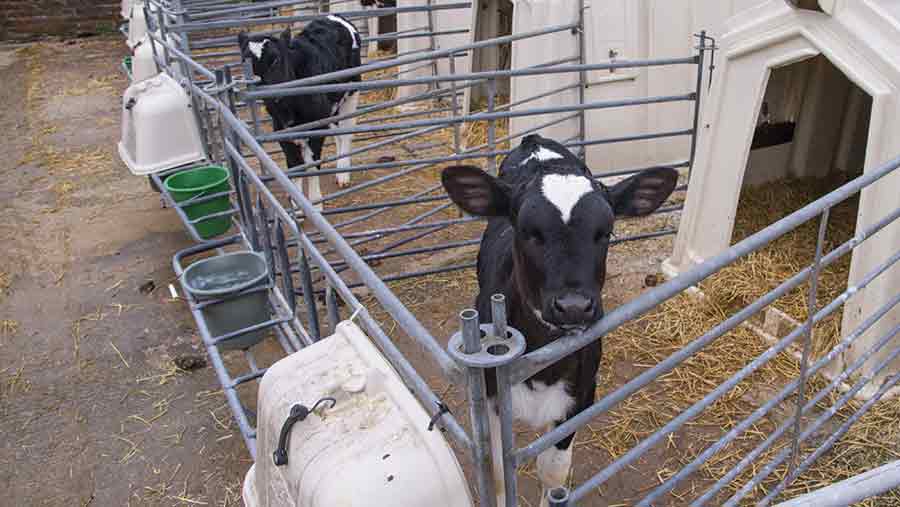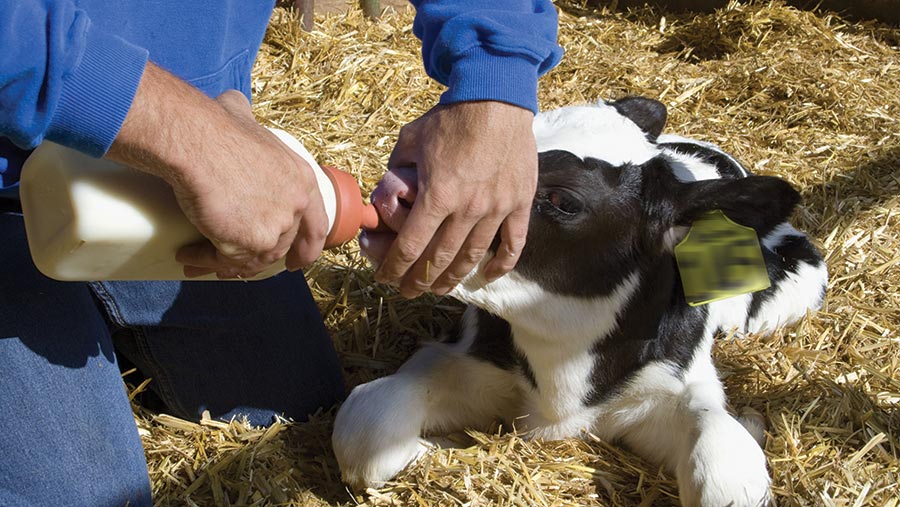Vets and Tesco defend single-calf rearing ban
 © FLPA/John Eveson/REX/Shutterstock
© FLPA/John Eveson/REX/Shutterstock Tesco’s ban on rearing calves in single hutches and pens has been met with heavy criticism from concerned veterinarians and farmers.
The Tesco Sustainable Dairy Group (TSDG) Livestock Code of Practice was revised in August and since then Farmers Weekly has been contacted by a number of farmers and calf rearers opposing the ban.
However, producers are too frightened to go on the record for fear of losing milk contracts.
Tesco initially told Farmers Weekly the move was due to welfare benefits, but has since added it is to counter vegan activists’ claims that dairy farming takes calves from their mothers and isolates them.
See also: Calf management tips to improve cow fertility
Tips to manage pairing calves from birth
Michael Wilkinson, Nantwich Farm Vets, Cheshire
- Colostrum needs to be supplied at 10% of bodyweight within 60 minutes of birth or as soon as possible. Pasteurisation can help.
- Cleanliness is vital. Disinfect between every group using a disinfectant that acts against cryptosporidia.
- Look to feed 10-15% more milk when temperatures drop below 10C, the point a calf needs more energy to stay warm.
- Some people have success with dummy teats (a teat that supplies no milk) but they can actually increase naval sucking. Feeding adequate milk and providing ad-lib starter and water is the best way to prevent cross-sucking.
Tips on reducing cross-sucking and managing bullying
Prof Robert Smith, school of veterinary science, University of Liverpool, and Paddy Gordon, Shepton Vets, Shepton Mallet
- Supplying fresh feed and chopped straw in the pen at the end of milk feeding can distract a calf, giving it a new target for oral behaviours, which could also increase feed intake.
- Consider feeding larger volumes of milk or higher rates of milk powder.
- Cross-sucking can be prevented by using bitter-tasting spray compounds to make areas of calves unattractive.
- Place animals in individual pens adjacent to the group for several feeds until cross-sucking behavior stops.
- Reduce competition at feeding time with temporary partitions. Research suggests 70cm partitions work, but some farms have had success with shorter partitions.
- Reduce competition for teats by supplying more teats than animals.
- Ensure calves are similar in stature and appetite. Where this is not possible, separate them when being fed milk.
- Quality milk is key. Ask your vet about protein and ash levels.
- Supply fresh water and feed 24 hours a day from a few days of age.
- Fresh water must be cold and milk must be warm. This helps ensure milk reaches the abomasum while water enters the rumen with the dry feedstuffs.
Several limitations
Veterinary surgeon Rose Jackson, Scarsdale Vets, Derbyshire, told Farmers Weekly that an across-the-board ban on single-pen-reared neonatal calves is “at best inappropriate and at worst contraindicated on some units”.
“It would be more appropriate to have a farm-specific approach in consultation with the farm’s own vets,” she added.
She said there were “several limitations” to studies cited by Tesco as supporting evidence for the ban, in particular the lack of data on pairing calves from birth.
“The studies were fairly small in terms of calf numbers [only eight calves in each treatment group], only one of them was based on UK-farming conditions and neither of them actually looked at group housing from birth.
“I have a number of concerns over group housing of calves from birth in terms of disease risk in general and cryptosporidium control in particular.”
In response, Tesco stated there were caveats around the pairing of calves if vets deemed it unwise to do so.

© Design Pics Inc/REX/Shutterstock
Disease implications
Paddy Gordon of Shepton Vets, Shepton Mallett, and adviser to Tesco on dairy standards, said research showed pairing calves does not carry an increased disease risk over individual housing.
He said pairing calves had been shown to increase competition for feed and lift intakes, but studies grouping calves in threes had shown a higher risk of disease transmission.
“Group housing does increase risk of disease, so pairing hits the middle ground of some competition without jeopardising health,” said Mr Gordon.
Q&A with Tesco agricultural manager Nic Parsons
What is the motivation behind the rule change?
We want to remove a major criticism of the dairy industry vegans and activists hold – that dairy removes babies form their mothers and puts them in isolation.
What are the benefits of pairing calves?
Increased socialisation and competition for feed leads to increased intake, faster growth rates and decreases stress at weaning.
Is there any flexibility or wriggle room for farms struggling to pair calves?
Individual pens will only be permitted where veterinary advice to do so is in place, but calves must still have visual and tactile contact. Calves must be grouped from eight weeks of age.
What will happen to non-compliant farms?
Farm audits will be undertaken looking at how farms are rearing calves starting in the next few weeks. Farms have been asked to declare whether they are non-compliant. Farms have until late May next year to make changes. If they remain non-compliant they could face contract suspension initially and eventually contract termination.
Why aren’t there studies looking at calves from day one?
Studies are designed to feed colostrum and get all calves to a healthy state before trials start. There is nothing to suggest that farms can’t bring calves together from 12-24 hours of age.
On the record: Farmers who have made the change
Dave Jones, Hardwick Farm, Monmouthshire. 180 year-round-calving Holstein Friesians
“The change coincided with the completion of us building a calf shed. We sold all our single hutches and bought some new double hutches.
“Calves go into double hutches from day one for five to 10 days and are then grouped in an igloo and fed on a machine. We find putting up to three calves in the double hutches works fine as there is enough room when they are small (5.8sq m). Our calf rearer says there has been an improvement in calf vitality – I suppose we will know more after we’ve seen 12 months’ worth of data.”
Christine Pickervance, Roseacre Hall, Preston, Lancashire. 500 year-round-calving cows, milking three times a day
“Initially, we were all quite sceptical at placing newborn calves in twos at birth, but we quickly overcame our concerns. It is always difficult implementing change. There have been quite a few positives.
“We use an individual bucket system and this still applies in the dual pens. The advantages are that the calves snuggle to keep warm, they compete and eat more and have natural behavioural development.
“We also find we use less straw and spend less time disinfecting pens because we have removed the divider to make double pens.
“The negative side is there has been some navel sucking and we need to monitor this. All our staff members are trained to feed good-quality colostrum to calves as soon as possibly after birth.
“At our rearing unit, where the baby calves go at a fortnight of age, they are grouped in pens of four. This has been very successful. At this point, volume of milk is increased significantly. We have been grouping them in fours from a fortnight old for about four years.”
